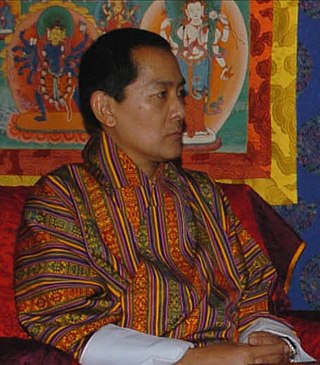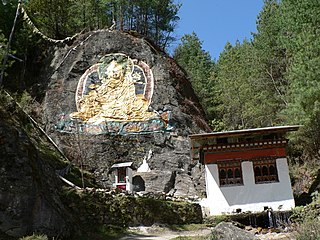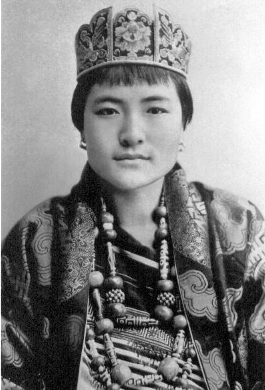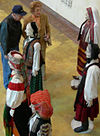
Thimphu is the capital and largest city of Bhutan. It is situated in the western central part of Bhutan, and the surrounding valley is one of Bhutan's dzongkhags, the Thimphu District. The ancient capital city of Punakha was replaced by Thimphu as capital in 1955, and in 1961 Thimphu was declared as the capital of the Kingdom of Bhutan by the 3rd Druk Gyalpo Jigme Dorji Wangchuck.

Jigme Singye Wangchuck is a member of the House of Wangchuck who was the king of Bhutan from 1972 until his abdication in favor of his eldest son, Jigme Khesar Namgyel Wangchuck, in 2006.

Jigme Dorji Wangchuck was the 3rd Druk Gyalpo of Bhutan.

Dechencholing Palace is located in Thimphu, the capital of Bhutan, 4 kilometres (2.5 mi) to the north of the Tashichho Dzong and 7 kilometres (4.3 mi) north of the city centre. It was built in 1953 by the third king of Bhutan Druk Gyalpo Jigme Dorji Wangchuck.
The Driglam Namzha is the official code of etiquette and dress code of Bhutan. It governs how citizens should dress in public as well as how they should behave in formal settings. It also regulates a number of cultural assets such as art and architecture. In English, driglam means "order, discipline, custom, rules, regimen" and namzha means "system", though the term may be styled "The Rules for Disciplined Behavior".

LyonpoSangay Ngedup was Prime Minister of Bhutan from 1999 to 2000 and again from 2005 to 2006.

The National Library of Bhutan (NLB), Thimphu, Bhutan was established in 1967 for the purpose of "preservation and promotion of the rich cultural and religious heritage" of Bhutan. It is located in the Kawajangtsa area of Thimphu, above the Royal Thimphu Golf Course, near the Folk Heritage Museum and the National Institute for Zorig Chusum.
Princess AshiKesang Choden Wangchuck, is a member of the royal family of Bhutan. She is a daughter of the fourth King of Bhutan Jigme Singye Wangchuck and Queen Mother Ashi Tshering Pem Wangchuck, one of the former king's four wives, all of whom are sisters and held the title 'queen consort'. She is a half-sister of the current Druk Gyalpo Jigme Khesar Namgyel Wangchuck, who became king following the abdication of his father Jigme Singye Wangchuck on 9 December 2006.

Bhutanese art is similar to Tibetan art. Both are based upon Vajrayana Buddhism and its pantheon of teachers and divine beings.

Queen Mother Sangay Choden is one of the four wives and queens of Bhutanese king Jigme Singye Wangchuck, who ruled in Bhutan from 1972 until his abdication in 2006. She is the Queen Mother of Bhutan.
Prince DashoUgyen Jigme Wangchuck is a member of the royal family of Bhutan and is the youngest of the sons of the fourth King of Bhutan Jigme Singye Wangchuck and his wife, Queen Mother Ashi Tshering Pem Wangchuck.

Desi Jigme Namgyal of Bhutan is a forefather of the Wangchuck Dynasty. He served as 48th Druk Desi of Bhutan (1870–1873), and held the hereditary post of 10th Penlop of Trongsa. He was called the Black Ruler.

Jetsun Pema is the Druk Gyaltsuen of Bhutan, as the wife of King Jigme Khesar Namgyel Wangchuck. She is currently the youngest queen consort in the world. She and the King have two children: Prince Jigme Namgyel Wangchuck, the heir apparent to the Bhutanese throne, and Jigme Ugyen Wangchuck.
HIV/AIDS in Bhutan remains a relatively rare disease among its population. It has, however, grown into an issue of national concern since Bhutan's first reported case in 1993. Despite preemptive education and counseling efforts, the number of reported HIV/AIDS cases has climbed since the early 1990s. This prompted increased government efforts to confront the spread of the disease through mainstreaming sexually transmitted disease (STD) and HIV prevention, grassroots education, and the personal involvement of the Bhutanese royal family in the person of Queen Mother Sangay Choden.
Bhutanese textiles represent a rich and complex repository of a unique art form. They are recognised for their abundance of colour, sophistication and variation of patterns, and the intricate dyeing and weaving techniques. The weavers, who are mostly women, must not be seen merely as creator of wealth but also as the innovators and owners of artistic skills developed and nurtured over centuries of time.

The Royal Textile Academy of Bhutan (རྒྱལ་འཛིན་ཐགས་རིགས་སློབ་སྡེ་) was founded to preserve and promote the living art of weaving which is an important part of the culture and tradition of Bhutan. Under the patronage of Her Majesty Ashi Sangay Choden Wangchuck, it is a non-government, non-profit organization established as an educational center for the training of individuals in traditional Bhutanese weaving.

Ashi Kesang Choden is the Queen Grandmother of Bhutan and the widow of the late Jigme Dorji Wangchuck. She participates in royal duties of her own accord. She is the only queen grandmother in the world. In Bhutan she is called The Royal Grandmother.

Ashi Phuntsho Choden (1911–2003) was the Queen consort of Bhutan.
Princess AshiEuphelma Choden Wangchuck is a princess of Bhutan. She is the daughter of the fourth King of Bhutan Jigme Singye Wangchuck and his wife, Queen Mother Ashi Sangay Choden Wangchuck. She is half-sister of the fifth King, Jigme Khesar Namgyel Wangchuck.

Ashi Tsundue Pema Lhamo (1886–1922) was the first Queen consort of Bhutan.














